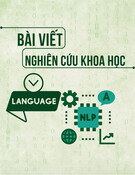
TNU Journal of Science and Technology
230(03): 101 - 107
http://jst.tnu.edu.vn 101 Email: jst@tnu.edu.vn
USING PODCASTS TO IMPROVE ENGLISH LISTENING SKILLS
FOR HIGH SCHOOL STUDENTS
Vu Dinh Bac*, Le Thuy Trang
TNU - University of Education
ARTICLE INFO
ABSTRACT
Received:
11/3/2025
This research aims to improve the English listening skills of high school
students through the use of podcasts. Experimental activities were conducted
over seven weeks with 44 students from class 10A8 at Song Cong High
School in semester 2 of the 2024-2025 school year. Participants were divided
into two groups: 22 students in the experimental group (using podcasts) and
22 students in the control group (not using podcast). Although all participants
completed both pre-tests and post-tests, only the experimental group
provided their feedback on using podcasts and suggestions for optimal
performance. The researcher used a quasi-experimental method with the
experimental group and designed podcast listening exercises using materials
from platforms such as YouTube and Spotify, which were relevant to the
topics covered in class. Research findings showed significant improvements
in students' listening skills, with the experimental group outperforming the
control group. Additionally, data collected from questionnaires and tests
underwent rigorous analysis to provide a comprehensive overview of the
effects of podcasts on listening skills and students' learning experiences. The
study also offers recommendations to optimize the integration of podcasts
into language learning, making them more effective, engaging, and
accessible while mitigating potential implementation challenges.
Revised:
31/3/2025
Published:
31/3/2025
KEYWORDS
Listening skills
English
Podcasts
High school students
Quasi-experimental
SỬ DỤNG CÁC PODCAST ĐỂ CẢI THIỆN KỸ NĂNG NGHE TIẾNG ANH
CHO HỌC SINH TRUNG HỌC PHỔ THÔNG
Vũ Đình Bắc*, Lê Thùy Trang
Trường Đại học Sư phạm - ĐH Thái Nguyên
THÔNG TIN BÀI BÁO
TÓM TẮT
Ngày nhận bài:
11/3/2025
Nghiên cứu này nhằm cải thiện kỹ năng nghe tiếng Anh của học sinh trung
học phổ thông thông qua việc sử dụng podcast. Các hoạt động thực nghiệm
được triển khai trong vòng bảy tuần với 44 học sinh lớp 10A8 tại Trường
THPT Sông Công trong học kỳ II năm học 2024-2025. Người tham gia
được chia thành hai nhóm: 22 học sinh thuộc nhóm thực nghiệm (sử dụng
podcast) và 22 học sinh thuộc nhóm đối chứng (không sử dụng podcast).
Mặc dù tất cả học sinh đều hoàn thành bài kiểm tra trước và sau thực
nghiệm, chỉ nhóm thực nghiệm cung cấp phản hồi về việc sử dụng podcast
cũng như đề xuất nhằm tối ưu hóa phương pháp này. Nghiên cứu áp dụng
phương pháp bán thực nghiệm với nhóm thực nghiệm, trong đó các bài tập
nghe từ podcast được thiết kế dựa trên tài liệu lấy từ các nền tảng như
YouTube và Spotify, đảm bảo phù hợp với các chủ đề được giảng dạy trên
lớp. Kết quả nghiên cứu cho thấy sự cải thiện đáng kể về kỹ năng nghe của
học sinh, với nhóm thực nghiệm có thành tích vượt trội hơn so với nhóm đối
chứng. Ngoài ra, dữ liệu thu thập từ bảng khảo sát và bài kiểm tra sẽ được
phân tích một cách chặt chẽ nhằm cung cấp cái nhìn toàn diện về tác động
của podcast đối với kỹ năng nghe và trải nghiệm học tập của học sinh.
Nghiên cứu cũng đưa ra các khuyến nghị nhằm tối ưu hóa việc tích hợp
podcast vào quá trình học ngoại ngữ, giúp phương pháp này trở nên hiệu
quả, hấp dẫn và dễ tiếp cận hơn, đồng thời giảm thiểu những thách thức có
thể phát sinh trong quá trình áp dụng.
Ngày hoàn thiện:
31/3/2025
Ngày đăng:
31/3/2025
TỪ KHÓA
Kỹ năng nghe
Tiếng Anh
Podcast
Học sinh trung học
Bán thực nghiệm
DOI: https://doi.org/10.34238/tnu-jst.12267
* Corresponding author. Email: bacvd@dhsptn.edu.vn

TNU Journal of Science and Technology
230(03): 101 - 107
http://jst.tnu.edu.vn 102 Email: jst@tnu.edu.vn
1. Introduction
English has established itself as a global language, playing an important role in many fields such
as technology, science, education, entertainment, economics and culture. As a result, the demand
for English proficiency continues to increase, especially among young learners who recognize its
importance for academic and professional success. In the Vietnamese context, English has been
integrated into the national education curriculum as a compulsory subject from grade 3 to grade 12,
emphasizing its significance in both educational and professional settings. According to Samad and
Fitriani (2016), English proficiency helps individuals access global knowledge, increase
competitiveness in the job market and foster international collaboration [1].
Among the four core language skills, listening plays a fundamental role in effective
communication and language acquisition. Rubin and Thompson (1994) emphasized that listening
constitutes approximately 60% of human communication, underscoring its importance in overall
language proficiency [2]. However, despite its importance, many Vietnamese high school
students still encounter significant difficulties in developing their English listening skills,
particularly when dealing with native-speaker accents, rapid speech, and varied intonations.
Meanwhile, Field (2008) pointed out that traditional teaching methods rely heavily on listening
exercises from textbooks, which often do not reflect the diversity of real-life language [3].
Classroom listening is often clearly spoken, slow, and contains few natural language elements
such as linking, colloquialisms, or communicative expressions. This can make it difficult for
students to listen to English in real-world environments [4]. Nguyen et al. (2020) identified
limited exposure to authentic communicative contexts as a primary factor contributing to these
challenges, highlighting the necessity of adopting innovative instructional approaches [5].
With the rapid advancement of digital technology, mobile and web-based learning platforms
have emerged as valuable tools in language acquisition. In particular, podcasts have attracted
attention as an effective means of improving listening skills by providing learners with authentic,
varied, and engaging language information. Vandergrift and Goh (2012) highlighted that frequent
exposure to real-world spoken English through podcasts can significantly improve listening
comprehension [6]. Despite their growing popularity, research on the integration of podcasts into
high school English curricula remains limited, especially in the context of Vietnamese education.
Therefore, this study aims to assess the effectiveness of using podcasts to enhance English
listening skills among high school students. Specifically, it explores the extent to which podcasts
contribute to improving listening abilities and overall language proficiency, thereby proposing
more appropriate and effective teaching methods.
1.1. Listening skills
Listening is a fundamental skill in language acquisition and communication, requiring both
physiological and cognitive processes. Brown (2001) defines it as a psychomotor process in
which sound waves are converted into nerve impulses and processed by the brain [7]. As the
most frequently used yet often overlooked language skill, listening plays a crucial role in
communication, education, and professional interactions. According to Brown (2011), when
neglected, it can lead to misinterpretations and communication breakdowns [8]. In language
learning, Krashen (1982) stated that listening serves as the foundation for pronunciation,
vocabulary, and grammar development [9]. Furthermore, listening skills are essential in language
learning, serving as the foundation for effective communication and comprehension. Strong
listening abilities enable learners to understand spoken language accurately, facilitating
interaction and engagement in real-world conversations. Additionally, proficient listening
enhances pronunciation, vocabulary acquisition, and fluency. Therefore, developing listening
skills through active practice is essential for achieving greater proficiency in a second language.
1.2. Understanding Podcasts

TNU Journal of Science and Technology
230(03): 101 - 107
http://jst.tnu.edu.vn 103 Email: jst@tnu.edu.vn
Radio is regarded as the forerunner of podcasts, originally serving as a medium for
broadcasting music and discussions to the public before evolving into a more personalized form
of content delivery. The term "podcast," a blend of "iPod" and "broadcast," was first introduced
by Rosell, as cited in Saputra [10]. In addition, Adam Curry and Dave Winer pioneered the
development of podcasts by creating a system that enabled the automatic download of internet
radio programs to iPods, a breakthrough that has since evolved into a widely accessible medium
available across multiple platforms and devices, as explained by Watson [11]. Today, podcasts
have become a ubiquitous medium, accessible across multiple platforms and devices, with
increasing application in educational settings.
Podcasts have gained prominence as a tool for language learning, particularly in Mobile-
Assisted Language Learning (MALL) environments. They provide an effective means for
improving listening and speaking skills by offering real-life listening experiences that help
learners develop more natural pronunciation. Essentially, they are audio files regularly uploaded
to the internet, accessible anytime, anywhere. Podcast content is diverse, covering topics such as
education, fashion, food, sports, and gaming. Acorrding to Rahimi and Katal (2019), podcasts
significantly improve listening comprehension and pronunciation in English as a Foreign
Language (EFL) learners by exposing them to authentic spoken language [12]. Similarly, Wang
and Liao (2020) emphasized the role of podcasts in promoting self-directed learning, allowing
learners to practice listening skills at their own pace and engage with content that suits their
proficiency level [13].
1.3. Characteristics, benefits, and drawbacks of Podcasts
Podcasts come in various formats, each serving different educational and entertainment
purposes. According to SZE (2020), common types include comprehensive podcasts that
combine listening comprehension activities, interviews, and vocabulary lessons [14]. Whole
lesson podcasts present structured lessons, often incorporating news articles with transcripts and
worksheets for guided learning. Vocabulary and idioms podcasts focus on word usage, while
scripted conversation podcasts feature dialogues between native speakers, accompanied by
transcripts to aid comprehension. Other formats include joke podcasts, which engage listeners
through humor, storytelling podcasts that enhance listening skills through narrated stories, and
poetry podcasts that introduce classic literary works. These diverse formats make podcasts a
versatile tool for educators and learners.
Podcasts offer several benefits, such as flexibility, enabling learners to acquire knowledge
while on the move or multitasking. Moreover, they provide a vast learning resource that enhances
listening comprehension, pronunciation, and vocabulary acquisition. They are also a low-cost,
accessible learning tool that spreads knowledge to a broad audience. Additionally, podcasts have
become a valuable tool in teaching listening skills, offering real-world content that exposes
students to various accents and expressions. Unlike scripted audio files in textbooks, podcasts
familiarize learners with natural language in different contexts. Learners can select content
suitable for their proficiency level, adjust playback speed, and practice in a personalized way.
Furthermore, educators can integrate podcasts into language lessons in multiple ways. For
instance, they can assign specific podcast episodes as listening assignments, followed by
comprehension quizzes or discussion activities. Teachers may also encourage students to create
their own podcasts as a speaking exercise, fostering both creativity and language production
skills [15]. Besides, podcasts can be used for note-taking exercises, transcription tasks, or
shadowing practice, helping learners improve their listening accuracy and pronunciation.
Despite their numerous advantages, podcasts also present certain limitations. According to
Alm (2021), one major drawback is the lack of visual support, which can make it difficult for
learners to understand complex concepts, especially in subjects that rely on diagrams and
illustrations, such as science and mathematics [16]. Additionally, Alm (2021) also highlighted

TNU Journal of Science and Technology
230(03): 101 - 107
http://jst.tnu.edu.vn 104 Email: jst@tnu.edu.vn
accessibility issues, noting that individuals with hearing impairments may struggle to engage
with podcasts, particularly when transcripts or slower speech options are unavailable [16].
Moreover, García-Sánchez (2023) identifies the overwhelming volume of podcast content as a
challenge, making it difficult for listeners to find reliable and high-quality sources [15]. Wang
and Liao (2020) further point out that some learners may find it hard to maintain focus during
long audio discussions, especially if the content is delivered in a monotonous tone or lacks
interactive elements [13]. Despite these challenges, podcasts remain a valuable educational tool,
particularly when supplemented with additional resources to enhance accessibility and
engagement.
2. Research method
This study employed a quasi-experimental research design to examine the effectiveness of
using podcasts in improving high school students’ English listening skills. Conducted over seven
weeks at Song Cong High School, the study involved 44 students from class 10A8, aged 15–16
years old. 22 of them were randomly chosen to join the experimental group and were asked to use
Podcasts as a method to improve their English listening skills (n = 22), while the others took part
in the control group. In addition, through the pre-test, the researchers would find that the
participants have difficulty listening to English, so their listening ability is limited. They were
chosen as the subject of the study because they used podcasts in the hope of improving their
listening skills effectively. The remaining 22 people were assigned to a control group that did not
use Podcasts to improve listening skills (n = 22). In fact, they were asked to do a test against the
experimental group to determine how different the results of both groups were in the pre-test and
post-test.
To assess students’ listening proficiency and attitudes, the study utilized pre-tests, post-tests,
and questionnaires. The pre-test and post-test were taken for the listening tests of the grade 10
final exam and consisted of 20 questions assessing skills such as identifying main ideas, specific
details, and inferring meaning. The research procedure included a pre-test and pre-questionnaire
(including 5 open-ended questions) in week 1 to assess listening ability and attitudes about
listening skills and the challenges they encountered while learning to listen. During weeks 2–6,
the experimental group participated in two podcast-based listening sessions per week. The
listening materials were designed by the researcher and sourced from platforms such as YouTube
or Spotify, based on the topics covered in the classroom textbook. Each listening exercise
consisted of two to three parts (about 10 - 15 questions) and lasted between 10 to 15 minutes.
Meanwhile, the control group completed listening activities from the textbook. In the final week,
participants took a post-test comprising 20 questions, and the experimental group completed four
open-ended questions in a post-questionnaire responding to the effectiveness of podcasts in
improving listening skills.
This study used Google Forms to collect and categorize questionnaire responses and Excel
2019 to calculate statistical data from the listening tests. Data collected from questionnaires and
tests were meticulously analyzed to provide a comprehensive overview of the impact of the
podcasts on students' listening skills and learning experience. A comparative analysis between
the test group (using podcasts) and the control group (not using podcasts) was conducted to
identify any notable differences in user proficiency. Students' scores after taking the test showed
how effective podcasts were in improving listening skills. By using quantitative data collection
methods, this research aimed to provide a comprehensive evaluation of the podcasts in
developing listening abilities among high school students.
3. Findings and discussion

TNU Journal of Science and Technology
230(03): 101 - 107
http://jst.tnu.edu.vn 105 Email: jst@tnu.edu.vn
The researcher analyzed the outcomes of the Pre-test and Post-test to demonstrate progress
following 7 weeks of experimentation. At the end of the 7 weeks, the score showed an increase,
suggesting that the students’ efforts after the course led to positive results.
Figure 1. The results of Pre-test
As shown in Figure 1, the pre-test results reflect the listening skills of 44 students before the
experiment. The test consisted of 20 questions, and the number of correct answers for each
student is represented by the bars in the chart. Some students performed relatively well, with the
highest number of correct answers reaching 17, indicating strong listening skills. On the other
hand, the lowest number of correct answers was 2, suggesting significant difficulties in listening
comprehension for some students. While some students answered fewer than 5 questions
correctly, the majority scored between 6 and 12, indicating that their listening skills were only
average. The distribution of results varies widely, reflecting significant differences in listening
abilities among the students.
Figure 2. The result of students’ scores in two tests (pre-test and post-test) in the experimental group
Through the research process, it can be seen that the scores of students in the experimental
group across two tests (Pre-test and Post-test) changed considerably after using podcasts to
improve listening skills (Figure 2). The results demonstrated that the post-test scores were
significantly higher than the pre-test scores for most students. Specifically, in the pre-test, many
students achieved only 4 to 10 correct answers, whereas in the post-test, the number of correct
answers increased significantly, with many students scoring between 10 and 18. Some students
0
2
4
6
8
10
12
14
16
18
S1 S3 S5 S7 S9 S11 S13 S15 S17 S19 S21 S23 S25 S27 S29 S31 S33 S35 S37 S39 S41 S43
Number of correct answers
0
5
10
15
20
S1 S2 S3 S4 S5 S6 S7 S8 S9 S10 S11 S12 S13 S14 S15 S16 S17 S18 S19 S20 S21 S22
Number of correct answers
Student's code
Pre -test Post - test




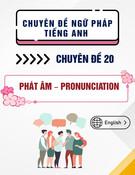






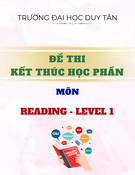
![Đề cương môn Tiếng Anh 1 [Chuẩn Nhất/Mới Nhất]](https://cdn.tailieu.vn/images/document/thumbnail/2025/20251130/cubabep141@gmail.com/135x160/51711764555685.jpg)


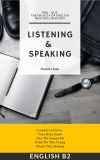





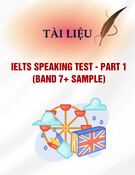

![Mẫu thư Tiếng Anh: Tài liệu [Mô tả chi tiết hơn về loại tài liệu hoặc mục đích sử dụng]](https://cdn.tailieu.vn/images/document/thumbnail/2025/20250814/vinhsannguyenphuc@gmail.com/135x160/71321755225259.jpg)
